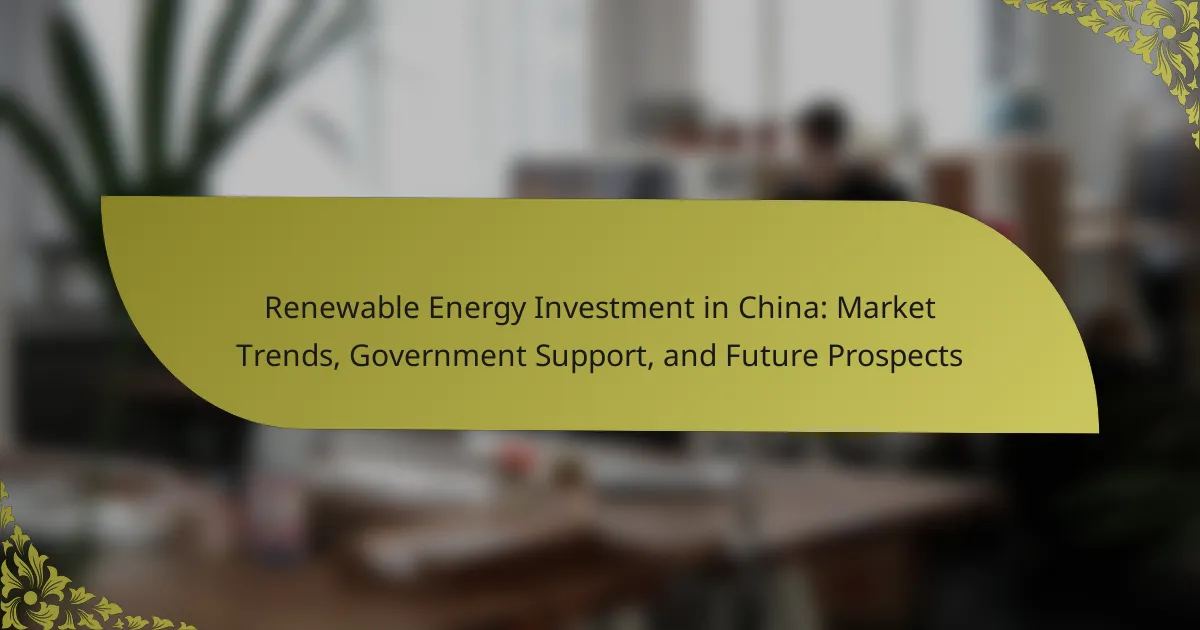Agricultural investment in China encompasses the financial resources allocated to enhance productivity, sustainability, and innovation in the agricultural sector. The Chinese government has prioritized this investment to ensure food security and improve rural livelihoods, with approximately 1.3 trillion yuan dedicated to agriculture in 2020. Key areas of focus include technology adoption, infrastructure development, and sustainable practices, all aimed at addressing challenges posed by climate change and urbanization. The article highlights the profitability outlook driven by increasing urbanization, government support for modernization, and the growing interest from foreign investors. Additionally, it discusses the importance of precision agriculture, public-private partnerships, and improved market access in maximizing investment outcomes.

What is Agricultural Investment in China?
Agricultural investment in China refers to the allocation of financial resources into the agricultural sector. This investment aims to enhance productivity, sustainability, and innovation within farming practices. In recent years, China has prioritized agricultural investment to ensure food security and improve rural livelihoods. For instance, the Chinese government invested approximately 1.3 trillion yuan in agriculture in 2020. This funding supports technology adoption, infrastructure development, and research initiatives. Additionally, foreign direct investment has also increased in China’s agricultural sector, reflecting growing market opportunities. These investments are critical for addressing challenges like climate change and urbanization impacts on agriculture.
How has agricultural investment evolved in China over the years?
Agricultural investment in China has significantly evolved over the years. In the late 20th century, China’s agricultural investment focused on increasing production through state-led initiatives. The introduction of the Household Responsibility System in 1978 marked a shift towards market-oriented reforms. This system incentivized farmers to invest in their land and improve productivity. By the early 2000s, investments began to diversify into technology and infrastructure. The government initiated policies to enhance rural development and modernize agriculture. In recent years, there has been a strong emphasis on sustainable practices and environmental protection. Reports indicate that China’s agricultural investment has consistently increased, reaching over $100 billion annually by 2020. This evolution reflects the country’s adaptation to both domestic needs and global market demands.
What historical factors have influenced agricultural investment trends?
Historical factors influencing agricultural investment trends include economic policies, technological advancements, and demographic changes. Economic policies, such as those implemented during the Green Revolution, prioritized agricultural productivity and led to increased investments in infrastructure and research. Technological advancements, including the introduction of high-yield crop varieties and modern farming equipment, significantly boosted investment attractiveness. Demographic changes, particularly urbanization and population growth, increased food demand, prompting further investments in agricultural production. Additionally, historical events like the Agricultural Adjustment Act in the U.S. shaped investment strategies by incentivizing farmers to manage supply and stabilize prices. These factors collectively shaped the landscape of agricultural investment over time.
How do government policies impact agricultural investment in China?
Government policies significantly influence agricultural investment in China. They shape the regulatory environment, affecting investment decisions. Policies provide financial incentives, such as subsidies for farmers and agribusinesses. These subsidies enhance profitability and encourage investment in modern farming techniques. Additionally, land use policies determine access to agricultural land. This access is crucial for attracting both domestic and foreign investment. Trade policies also impact agricultural exports and imports, influencing market dynamics. For instance, tariffs can protect local farmers but may deter foreign investments. Overall, government policies create a framework that can either stimulate or hinder agricultural investment in China.
What are the key components of sustainable agricultural practices in China?
Key components of sustainable agricultural practices in China include crop rotation, organic farming, and integrated pest management. Crop rotation enhances soil fertility and reduces pest buildup. Organic farming minimizes chemical use, promoting biodiversity and soil health. Integrated pest management combines biological control and minimal chemical application to manage pests sustainably. These practices contribute to long-term agricultural productivity and environmental protection. Research indicates that implementing these methods can increase yields while reducing environmental impact. For example, studies show that organic farming can lead to a 20% increase in crop yield compared to conventional methods.
How do sustainable practices contribute to environmental conservation?
Sustainable practices contribute to environmental conservation by minimizing resource depletion and reducing pollution. These practices include crop rotation, organic farming, and agroforestry. Crop rotation enhances soil health and prevents erosion. Organic farming reduces chemical runoff into water systems. Agroforestry integrates trees into agricultural landscapes, promoting biodiversity. According to the Food and Agriculture Organization, sustainable agriculture can increase food security while preserving ecosystems. Implementing these methods can lead to a decrease in greenhouse gas emissions, as reported by the Intergovernmental Panel on Climate Change. Overall, sustainable practices create a balanced approach to agriculture that supports environmental health.
What technologies are being adopted to promote sustainability in agriculture?
Precision agriculture technologies are being adopted to promote sustainability in agriculture. These technologies include GPS-guided equipment, soil sensors, and drone monitoring. GPS-guided equipment optimizes field-level management by using satellite data. Soil sensors provide real-time data on moisture and nutrient levels. Drone monitoring allows for efficient crop surveillance and health assessment. Additionally, vertical farming techniques are being implemented to maximize space and resource use. Hydroponics and aquaponics are also gaining traction for their water efficiency. These technologies collectively enhance productivity while minimizing environmental impact. Research indicates that precision agriculture can increase yields by up to 15% while reducing input costs.
Why is market demand crucial for agricultural investment in China?
Market demand is crucial for agricultural investment in China because it drives production decisions and resource allocation. High market demand encourages farmers to invest in better technologies and practices. This leads to increased efficiency and higher yields. Furthermore, strong demand can boost the profitability of agricultural ventures. In 2021, China’s agricultural sector saw a growth of 3.1% due to rising consumer demand for diverse food products. This trend highlights the importance of understanding market preferences. Investors are more likely to fund projects that align with consumer needs. Therefore, market demand directly influences the sustainability and success of agricultural investments in China.
What factors drive market demand for agricultural products in China?
Market demand for agricultural products in China is driven by several key factors. Population growth significantly increases the need for food. China’s population reached approximately 1.4 billion in 2023, creating a higher demand for agricultural output. Urbanization trends also play a crucial role. As more people move to cities, their dietary preferences shift towards higher-quality and diverse food products.
Economic growth contributes to increased purchasing power. As China’s GDP continues to rise, consumers are willing to spend more on premium agricultural goods. Health awareness among consumers is another influencing factor. There is a growing preference for organic and nutritious products, which boosts demand for specific agricultural items.
Government policies and support for agriculture also impact market demand. Initiatives aimed at enhancing food security and sustainability encourage production and consumption of local agricultural products. Lastly, international trade dynamics affect availability and prices of agricultural goods. China’s participation in global markets influences domestic demand patterns.
How do consumer preferences shape agricultural investment strategies?
Consumer preferences significantly influence agricultural investment strategies. Investors prioritize crops and farming methods that align with consumer demand. For example, the rise in demand for organic produce has led to increased investments in organic farming practices. Research indicates that 70% of consumers are willing to pay more for organic products. This trend drives farmers to adopt sustainable practices to meet market expectations. Additionally, preferences for local sourcing encourage investments in regional food systems. Data shows that local food markets have grown by 25% in recent years. These shifts in consumer behavior directly impact investment decisions in agriculture.

What are the profitability outlooks for agricultural investment in China?
Agricultural investment in China shows a positive profitability outlook. The country’s increasing urbanization drives demand for food and agricultural products. Government policies support modernization and innovation in agriculture. Technological advancements enhance productivity and efficiency in farming. Investment opportunities exist in organic farming and sustainable practices. The market for high-quality agricultural products is expanding. Reports indicate a growing interest from foreign investors in China’s agricultural sector. Overall, the combination of demand, policy support, and innovation contributes to a favorable profitability outlook.
How do current market trends affect profitability in agricultural investments?
Current market trends significantly influence profitability in agricultural investments. Trends such as rising consumer demand for organic produce increase market prices. Additionally, advancements in technology improve crop yields and reduce costs. For instance, precision agriculture techniques can enhance efficiency. Fluctuating commodity prices also impact profit margins directly. According to the Food and Agriculture Organization, global food prices rose by 30% in 2021, affecting investment returns. Furthermore, changing policies regarding sustainability encourage investments in eco-friendly practices. These trends collectively shape the financial landscape for agricultural investors.
What role does international trade play in agricultural profitability?
International trade significantly enhances agricultural profitability by expanding market access for farmers. It allows producers to sell their products to a larger audience beyond domestic markets. This access can lead to higher prices for agricultural goods due to increased demand. For example, China’s agricultural exports have grown, contributing to improved income for farmers. In 2020, China’s agricultural exports reached $79 billion, reflecting the benefits of international trade. Additionally, trade can introduce competition, encouraging local farmers to innovate and improve efficiency. Overall, international trade plays a crucial role in boosting agricultural profitability through market expansion and increased revenue opportunities.
How do production costs influence profit margins in Chinese agriculture?
Production costs directly impact profit margins in Chinese agriculture. Higher production costs reduce the difference between total revenue and expenses. For instance, if costs for seeds, fertilizers, and labor increase, farmers earn less profit. According to a report by the Food and Agriculture Organization, rising input costs have led to tighter margins for many agricultural producers. Conversely, lower production costs can enhance profit margins. Efficient farming techniques and economies of scale can help reduce overall expenses. Research indicates that adopting sustainable practices can lower costs and improve profitability in the long run. Thus, effective management of production costs is crucial for maintaining healthy profit margins in Chinese agriculture.
What challenges do investors face in the agricultural sector in China?
Investors in the agricultural sector in China face multiple challenges. Regulatory complexities hinder investment decisions. The government imposes strict policies on land use and farming practices. Climate change impacts crop yields and increases risks. Water scarcity affects agricultural productivity in various regions. High competition from local farmers presents market entry challenges. Additionally, investors encounter difficulties in supply chain logistics. Labor shortages can also affect operational efficiency. These factors collectively complicate the investment landscape in China’s agricultural sector.
How do climate change and environmental issues impact agricultural investment?
Climate change and environmental issues significantly impact agricultural investment. These factors lead to increased risks such as crop failure and reduced yields. For example, changing weather patterns can cause droughts or floods. Such conditions threaten the stability of agricultural production. Investors may perceive these risks as detrimental to profitability. Consequently, they may hesitate to invest in affected regions. Additionally, stricter environmental regulations can increase operational costs for farmers. This further discourages investment in agriculture. Research indicates that climate-related risks could reduce agricultural GDP by up to 30% in vulnerable areas. Thus, the interplay between climate change and agricultural investment is crucial for future planning.
What regulatory hurdles must investors navigate in China’s agricultural market?
Investors in China’s agricultural market must navigate several regulatory hurdles. These include compliance with national and local agricultural policies. Investors face restrictions on land use and ownership. Foreign investments are subject to scrutiny under the Foreign Investment Law. Environmental regulations impact agricultural practices and product standards. Import and export regulations can complicate market entry. Additionally, investors must adhere to food safety laws and quality control measures. Compliance with these regulations is essential for successful investment in China’s agricultural sector.

What best practices can enhance agricultural investment outcomes in China?
Implementing precision agriculture can significantly enhance agricultural investment outcomes in China. Precision agriculture utilizes technology to monitor and manage field variability. This approach optimizes inputs like water, fertilizers, and pesticides. It can lead to increased crop yields and reduced costs. According to a study by Zhang et al. (2021), precision farming techniques can improve productivity by up to 20%.
Additionally, fostering public-private partnerships is crucial. These partnerships can leverage resources and expertise. They can provide farmers with access to advanced technologies and financial support. Research from the China Agricultural University indicates that such collaborations can enhance investment efficiency.
Investing in sustainable practices also plays a vital role. Sustainable methods improve soil health and biodiversity. They can lead to long-term profitability. A report from the Food and Agriculture Organization (FAO) highlights that sustainable agriculture can increase resilience to climate change.
Finally, enhancing market access is essential for investment success. Improved infrastructure and logistics can connect farmers to broader markets. This access can lead to better pricing and reduced post-harvest losses. The World Bank emphasizes that better market access can increase farmers’ incomes by 30%.
How can investors identify and leverage sustainable agricultural opportunities?
Investors can identify and leverage sustainable agricultural opportunities by analyzing market trends and demand for eco-friendly products. Research indicates that the global market for organic food is projected to reach $320 billion by 2025. Investors should assess local agricultural practices and regulations that support sustainability. Engaging with farmers who implement sustainable methods can reveal viable investment options. Additionally, technology in precision agriculture enhances resource efficiency and productivity. Reports show that investments in sustainable practices can yield higher long-term returns. Collaborating with agricultural cooperatives can provide insights into community needs and sustainable practices. Overall, thorough market research and partnerships are essential for successful investments in sustainable agriculture.
What metrics should investors use to assess the viability of agricultural projects?
Investors should use metrics such as return on investment (ROI), net present value (NPV), and internal rate of return (IRR) to assess the viability of agricultural projects. ROI measures the profitability relative to the investment cost. NPV evaluates the projected cash flows discounted to present value, indicating whether the project will generate value over time. IRR represents the discount rate that makes NPV equal to zero, helping to compare the profitability of different projects. Additionally, investors should consider market demand, production costs, and sustainability practices. These factors influence long-term profitability and risk. For instance, a study by the Food and Agriculture Organization highlights that sustainable agricultural practices can enhance yield and profitability, reinforcing the importance of these metrics.
How can collaboration with local farmers improve investment success?
Collaboration with local farmers can improve investment success by ensuring access to valuable local knowledge and resources. Local farmers understand regional soil conditions and climate, which can lead to better crop yields. This knowledge allows investors to make informed decisions about what crops to plant. Additionally, partnering with local farmers can enhance supply chain efficiency. Local sourcing reduces transportation costs and time. This can lead to fresher produce and higher quality products. Collaborative efforts can also foster community support and trust. Engaging local farmers can create a loyal customer base. According to a study by the International Food Policy Research Institute, investments in local agriculture yield higher returns when farmers are involved in decision-making processes. This evidence supports the notion that collaboration enhances investment outcomes.
What resources are available for investors in China’s agricultural sector?
Investors in China’s agricultural sector have access to various resources. These include government policies that support agricultural investment. The Ministry of Agriculture and Rural Affairs promotes initiatives for foreign investment. Additionally, there are financial incentives such as subsidies and tax breaks. Research institutions provide valuable data and insights into market trends. Agricultural technology firms offer innovative solutions to improve productivity. Industry associations facilitate networking and information sharing among investors. Furthermore, online platforms provide access to market intelligence and investment opportunities. These resources collectively enhance the investment landscape in China’s agricultural sector.
Where can investors find market research and analysis on agricultural trends?
Investors can find market research and analysis on agricultural trends through various reputable sources. Industry reports from organizations like the Food and Agriculture Organization (FAO) provide comprehensive insights. Market research firms such as IBISWorld and Statista offer detailed analyses specific to agriculture. Academic journals like the Journal of Agricultural Economics publish research studies that explore current trends. Additionally, government publications from agricultural departments often include valuable data and forecasts. These resources collectively offer a solid foundation for understanding agricultural market dynamics.
What networks or organizations support agricultural investment in China?
The China Agricultural Development Bank (CADB) supports agricultural investment in China. CADB provides financial services specifically aimed at agricultural projects. Another key organization is the Ministry of Agriculture and Rural Affairs. This government body formulates policies to promote agricultural investment. The China National Agricultural Development Group Corporation also plays a significant role. It focuses on enhancing agricultural productivity and investment opportunities. Additionally, the Asian Development Bank supports agricultural investments through various funding programs. These organizations collectively contribute to the growth of agriculture in China. Their efforts are critical for sustainable agricultural practices and market competitiveness.
Agricultural investment in China encompasses the allocation of financial resources to enhance productivity, sustainability, and innovation within the agricultural sector. The article explores the evolution of these investments, highlighting the impact of government policies, market demand, and historical factors on investment trends. It also examines key components of sustainable practices, the role of technology, and profitability outlooks, while addressing challenges investors face, including regulatory hurdles and climate change. Additionally, the article identifies best practices and resources available for investors to optimize their agricultural ventures in China.



